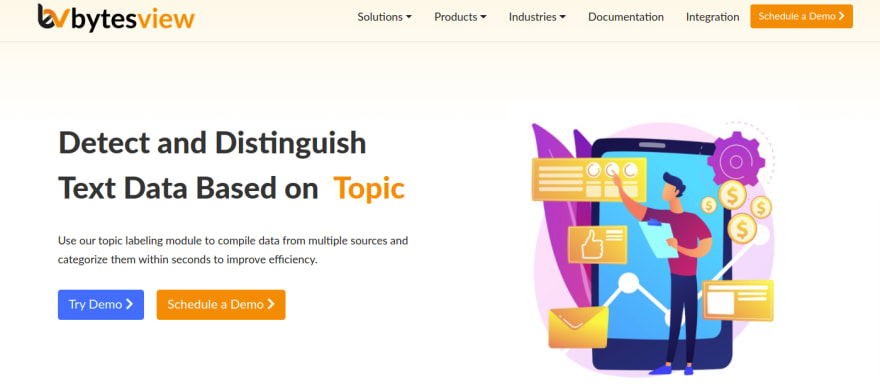Topic labeling is a machine learning and NLP technique that helps in extracting meaning from a large volume of unstructured texts on the basis of recurrent themes or topics.
Businesses generate a large volume of documents and unstructured text on a daily basis such as social media posts, emails, forum discussions, reviews, and customer support tickets. But when it comes to analyzing and making sense of this data, it is far too big to process manually. If you go ahead and start analyzing the data manually, it will be too time-consuming and repetitive that you are bound to make mistakes, plus it won’t scale much.
This is where the relevance and importance of topic labeling come into play. AI-guided topic analysis can make it much easier and faster to accurately analyze and extract large volumes of data. All you need to do is to sign up for a good topic analysis providing software such as Bytesview, monkeylearn, lexalytics, etc to get through. Now let’s dive deep into the topic.
What is Topic Labeling?
Topic labeling, also called topic modeling, topic detection, or topic extraction, is a machine learning and NLP technique that examines and understands large collections of text data by assigning “tags” or categorizing documents/paragraphs based on the topic or theme of the text.
Topic Labeling tools-
1. BytesView- BytesView is an efficient tool that you can use to automate the classification of documents with topic labeling and text categorization. It helps you segregate documents by identifying clusters of words from unstructured text data within minutes with guaranteed accuracy.
2.Monkeylearn- MonkeyLearn provides a simple graphical interface where users can create customized text classification and extraction analysis by training machine learning models such as topic detection, keyword extraction, and more. It can be integrated with hundreds of other applications through its direct integrations and open API.
Topic labeling approaches
NLP topic modeling and NLP topic classification are the two most common approaches for topic analysis with machine learning.
topic-modeling- It is an unsupervised machine learning technique. It can infer clusters and patterns comparable utterances without the need for subject tags or training data in advance. However, there is a drawback to this type of algorithm: it lacks accuracy.
topic classification- Topic classification requires knowing the topics before starting analyzing. You need to tag a substantial volume of data to train the classifier. Even though the approach is more time-consuming than topic modeling, in the long run, it is way more accurate. It all depends on the quality of the data you train it with.
scope and levels at which you can apply topic analysis
sentence-level: the topic of a single sentence is derived using this model. For example, the topic of a fashion magazine headline.
sub-sentence level: the topic of sub-expressions from within a sentence can be derived from this topic model. For example, different topics within a single sentence from feedback.
document-level: different topics from within a complete text is fetched from this topic model. For example, the topics of a news article or a blog.
Why is topic labeling important?
Organizations generate and accumulate massive amounts of unstructured text data every day. Automated topic labeling approaches provide immense benefits including making better decisions, finding new patterns, streamlining operations, and identifying trends.
When it comes to sorting through all this data, machine learning models are crucial. We can efficiently scan large amounts of text using topic identification and can find out what our clients are talking about.
Applications of Topic Labeling
Product Analytics- Making improvements from scratch to an existing product or developing is not easy. one needs to get insights about the consumers’ needs, finding out which features are most sought-after, and which combination of features works the most. You need to dive into the data of your competitors to get these insights. You can analyze their services and products, how customers respond to them, which improvements do they seek, which features are unnecessary etc.
Brand Monitoring- topic identification and analysis help you to get insights about your brand by detecting and tracking the different areas of your business people are discussing the most. The real-time topic analysis allows you to keep track of your brand image and also helps to monitor your competitors and detect the latest trends in your industry.
Social Media Monitoring- Social media is a vast pool of user-generated information often related to brands, products, organizations, and services, with these immense volumes of textual data, even finding the information related to a relevant topic is difficult, let alone analyze it. you can use topic analysis to sort this problem out and gain insights you actually need to focus on.
Wrapping Up
The topic analysis has made it possible to detect subjects and topics within huge sets of text data simple and efficient way. It allows you to automate your business. Start training your custom topic labeling model today.





Top comments (0)